Intro
Terrible time than this, the great Roman Empire crumbles to disappear, the great emperors have lost their panache. The Germanic tribes extended, they pushed back the frontiers of the Empire. The Roman legions lost their effectiveness in the face of barbarian fervor. This period is dark and enigmatic, the world is gradually entering the Middle Ages.
The context of the time
The legacy of the Franks
Civilized barbarians, the Frankish tribes began to move at the same time as the Germans. The most active among them are the Francs Ripuaires and Saliens. The Ripuaires (or Rhinelanders) extended over the Rhine valley to the right of the Rhine. The Saliens are from Dutch territory, they moved towards the southwest and invested the north of Gaul. Like other barbarian peoples, the Franks recognized the authority of a king. The first rulers of the Francs Saliens are legendary kings such as Clodion the Hairy and Merovée (who gave his name to the Merovingian dynasty). The latter had helped the Romans of Aetius to chase Attila from Gaul, a gigantic battle had taken place in the Catalaunian Fields where the Huns were beaten. Childeric I succeeded Merovée, with whom no relationship is established. He first led a life of debauchery and was driven out of his kingdom. Restored a few years later, he helped the Romans of Aegidius to drive out the Visigoths. (note:an article on the Franks will be the subject of further study) .
Childeric's Tomb
Childeric's tomb was discovered in Tournai in 1653 by a deaf and dumb mason. It astonishes by its pagan and Germanic origin. The king is buried with his horses, wearing a silver bracelet on his arm and by his Roman aspect. He wore a purple mantle held by a golden fibula, specific to the Roman general and a ring on his finger used to seal the acts and bearing the inscription:Childericus rex (Childeric king). The mantle was adorned with golden bees, a Merovingian symbol that Napoleon I later adopted to recall the origins of France.
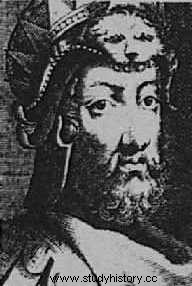
Childeric I
Gaul, a mosaic of peoples
Gaul was the most cultured and richest province of the Roman West. It was with Brittany one of the first provinces to be abandoned by the Romans. With the weakening of the imperial defenses it fell very quickly into the hands of the Barbarians:
- In the South-West, the Visigoths (Spain and Aquitaine).
- In the southeast, the Ostrogoths (northern Italy).
- The Centre-East became the country of the Burgundians (one of the rare peoples converted to Christianity).
- Between the Loire and the Somme, a Roman general carved out a kingdom whose capital was Soissons. Considering himself the "King of the Romans", he tried to maintain Latin civilization.
Thus Gaul represented a mosaic of cultures and a main stake for the new king of the Salians:Clovis, son of Childeric.
Gaul at the advent of Clovis

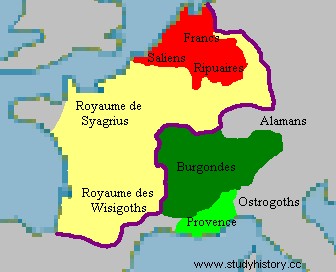
The first name Clovis
Clovis was actually called Chlodowech (illustrious in the war), historians distorted it into Clovis. The first name evolved under the Carolingians:Chlodowichus then Lodovicus before becoming Ludovicus then Ludovic nowadays. In western France, the first name becomes Lodoïs then Louis. Clovis can thus be considered as Louis I!
The Reign of Clovis
Conquering the Kingdom of Syagrius
At 15, Clovis was still a beardless young boy when he was hoisted on the bulwark (shield) to be proclaimed king of the Franks at Tournai in 481. The kingdom was thin and other saliens controlled the neighboring regions, but Clovis benefited from the work of his father Childeric. Very quickly the young king wants to assert himself and refuses to share his power as his father had done. He brought together the small neighboring tribes and allied himself with two other Salian kings (Ragnacaire and Chararic) in order to seize the kingdom of Syagrius as well as his city:Soissons. War declared in 486, Clovis and his troops triumphed over the Romans at the gates of Soissons. Syagrius then comes to take refuge with the leader of the Visigoths:Alaric, but for fear of reprisals, Alaric delivers the Roman leader to Clovis who cut his throat. Thanks to the ransoms obtained for the release of wealthy notables and the booty amassed during the conquest, he was able to form a standing army. Continuing his victorious march, he extended the kingdom of the Franks to Brittany and the Loire.
The vase of Soissons
After the capture of Soissons, the spoils, as was customary, had to be shared between the king and his men. However, Clovis, wanting to offer a beautiful vase found in the looting of Soissons to the bishop of Reims, placed it outside. This angered one of his warriors who publicly accused Clovis of cheating, and according to legend smashed the magnificent vase. A year later, during a military review, Clovis recognized the warrior and threw his ax to the ground, the warrior bent down to pick it up and Clovis gave him a blow on the head with his francisque, saying:"Thus did you made with the Soissons vase”. Doubts remain on this legend, indeed the vase would not have been destroyed and given to Saint-Rémi.
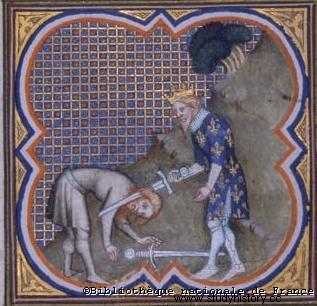
Revenge of Clovis (National Library of France)
Clotilde's influence
During this time, Theodoric the Great Chief of the Ostrogoths imposed a great kingdom on Italy, he married one of the sisters of Clovis. Wanting to escape the power of the Goths, Clovis sought an alliance with the Burgundians. Thus a marriage was arranged between Clovis and Clotilde, the daughter of the chief of the Burgundians. Having received a Catholic education, Clotilde worked to convert her husband, whose people practice pagan worship. But in the East, the Alamans attacked the borders, threatening the Burgundians, the Saliens and the Ripuaires. A confrontation takes place in Tolbiac in 496, the battle goes to the advantage of the Alamans, after having invoked the pagan gods, Clovis returns to the god of Clotilde and swears to him to convert if he wins the battle. Miraculously, the Alemanni chief is killed. Soon his soldiers flee and are routed. It then remained for the Frankish chief to respect his wish.
The fleur-de-lis
During the battle of Tolbiac, an angel proposed to Clovis to exchange the three toads (pagan symbol) which adorned his shield against three gold lilies. Thus, the fleur-de-lys became the emblem of the French monarchy until 1830. It still flies on the flag of Quebec.
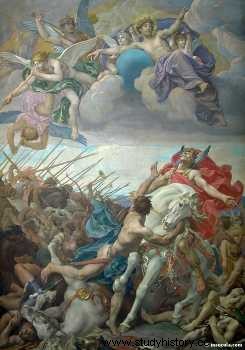
Vow of Clovis at the Battle of Tolbiac - by Paul-Joseph BLANC (Panthéon)
The conversion of the Franks
Beyond the promise made to Tolbiac, Clovis knew that he could derive an advantage from his conversion to Catholicism. Indeed, it could attract the benevolence of the Gallo-Roman populations, most of whom were governed by Arian kings. However Clovis hesitated, half of his people worshiped pagans, Queen Clotilde asked for the support of Bishop Rémi who greatly influenced Clovis. Thus, in Reims on Christmas Eve 497 (or 498,499?), Saint-Rémi baptized Clovis with 3,000 of his soldiers. The Gallo-Roman populations welcomed the Franks no longer as invaders but as liberators. The Church, which was the highest spiritual authority, thus chose the camp of the Franks.
Baptism
It was an impressive ceremony which brought together Frankish chiefs and Gallo-Roman notables who submitted to the authority of the king. Thereafter, the action of Clovis was favored by the Church:“Every day, God made the enemies fall under his hand because he walked with a pure heart before the Lord. »
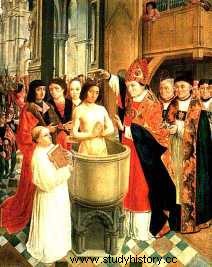
The Baptism of Clovis - by LE MAÎTRE DE ST-GILLES (Washington. National Gallery)
The Visigoths
Around the year 500, Clovis intervenes in a family quarrel of the Burgundians. Chilpéric, Clotilde's father is assassinated by his brother Gondebaud. After having confronted Gondebaud to avenge his wife, Clovis resolves to sign a treaty of alliance with him in 502. This new alliance worried more and more Alaric the leader of the Visigoths who informed Theodoric of the Ostrogoths. Clovis trained his Frankish tribes as well as the Burgundians at Vouillé near Poitiers to confront the Visigoths, enemies of the Franks for a long time. Alaric II was defeated and killed by Clovis' own hands. Theodoric's army was held back by the Byzantines of Emperor Anastasius, who signed an alliance with the Franks. Clovis then seized Toulouse, capital of the Visigoths, as well as the legendary treasure of Alaric.
Alaric's Treasure
Legend has it that in 52, Emperor Titus found Solomon's treasure while sacking Jerusalem. Subsequently, Alaric I seized it during the sacking of Rome in 410. This treasure was the largest in the West and contained the Holy Grail. Other sources state that the Visigoths transported the treasure to the ramparts of Carcassonne where Clovis ended up. It was located in the well of Carcassonne, in the mountain of Alaric or in the castle of Montségur where the Cathars had a position. At the beginning of the 20th century, a priest Béranger Saunière spent colossal fortunes without anyone knowing where his wealth came from. It is then believed that he discovered Alaric's treasure and illegally trafficked with the Austrian court.
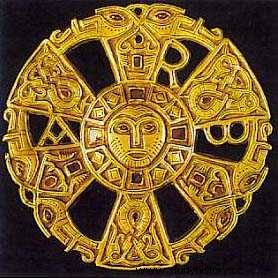
Limons (Puy de Dôme):openwork fibula, gold and garnets, late 6th c. Head of Christ in the center of a Chrisme, Ø 63 mm, BN Paris
The reunification of the tribes
After the victory of Vouillé, Clovis received in Tours the sign of the benevolent protection of the Eastern Roman Empire which gave him the title of consul and august. This investiture raised him as a legitimate sovereign, so he worked to reunite the Frankish kingdom which is still fragmented by the existence of small territories governed by kings. Clovis began to attack Chararic and Ragnacaire his two Saliens allies against Syagrius, he had the head shaved at the first (the hair was the symbol of royal power, so the soldiers had their necks shaved), then he executed them. The Saliens unified, there remained the Francs Ripuaires to submit. Clovis implemented a demonic scheme, by inciting the prince of the Ripuaires to assassinate his father Sigebert the king. Subsequently, the young prince was killed while bringing the treasures of his kingdom to Clovis. Clovis then knew how to convince the Ripuarian population to choose him as king. This barbaric attitude disconcerted the entourage of the King of the Franks.
The successors of Clovis
Sharing the kingdom
In 509, Clovis chooses Paris as the new capital of his kingdom, the city is already an active pole of Gaul and was the place of residence of certain Roman emperors, we also speak of the influence of Sainte-Geneviève (patroness of the city ) on Childeric then Clovis. Considering himself the head of the Church, Clovis worked to convert all of Gaul to Catholicism. In 511, Clovis brought together the bishops at the Council of Orleans, the Merovingian Church was then born. The same year, the great king died in Paris, he was buried near Sainte-Geneviève. The Salic law that governed Frankish customs excluded women from inheritance. Thus, as tradition dictated, the kingdom was divided between the four sons of Clovis. Merovingian unity was lost and the territories thus formed would challenge each other for years.
The first share

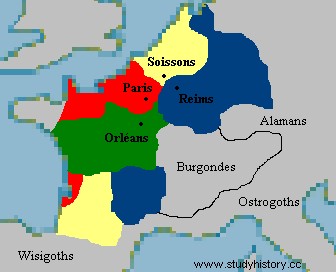
Thereafter, to better understand the fratricidal quarrels, it is advisable to have the genealogy of the Merovingians in front of you
The sons of Clovis (Thierry I, Clodomir, Childebert I, Clotaire I)
The first of the sons of Clovis, Thierry had inherited the territories most exposed to external invasions, so his experience should enable him to deal with them. He was not the son of Clotilde but of a Rhineland princess, so he was more distant with his three half-brothers Clodomir, Childebert and Clotaire who acted together. The latter rekindled hostilities with the Burgundians to avenge their mother Clotilde (Clovis had resolved to sign peace with the Burgundians), this confrontation resulted in the death of Clodomir. Childebert and Clotaire then assassinate the sons of Clodomir in order to share their brother's territory. Having had no male heir, Childebert ceded his kingdom to Clotaire at his death, who thus became master of the entire Frankish kingdom, Thierry and his descendants being all dead. A second partition took place in 561 between his four sons:Caribert I, Gontran, Sigebert I and Chilpéric I.
The second share

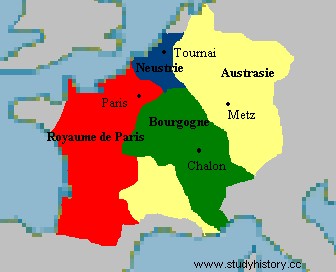
The sons of Clotaire (Caribert I, Gontran, Sigebert I, Chilpéric I)
Caribert dies prematurely, his three brothers share his kingdom. A family quarrel will plunge the other three brothers into a ruthless war. Accompanied by his mistress Frédégonde, Chilpéric suffocates his own wife during her sleep. Only, the wife of Chilpéric is the sister of Brunehaut, the wife of Sigebert. A merciless struggle will then begin between:
- Chilpéric and his new wife Frédégonde (Neustria)
- Sigebert and his wife Brunehaut (Austrasia)
In the middle, Gontran first takes Sigebert's side and together they manage to take the advantage. But after falling out with the latter, Gontran now allies with Chilpéric. Sigebert is assassinated by two henchmen of Frédégonde (wife of Chilpéric), his son Childebert II passes under the tutelage of Gontran then leaves him for Chilpéric. But very quickly, the fight resumes between the last two brothers:Chilpéric, always more arrogant, and Gontran. The death of Chilpéric, assassinated by an unknown person, does not calm the hostilities. The two queens of Austrasia and Neustria:Brunehaut and Frédégonde perpetuate the struggle of the two kingdoms by orchestrating assassinations and games of alliances. Despite this, Childebert II and his uncle Gontran get closer again, they seal an alliance which allows Childebert to recover the kingdom of Gontran at the death of the latter.
Assassination of Sigebert I
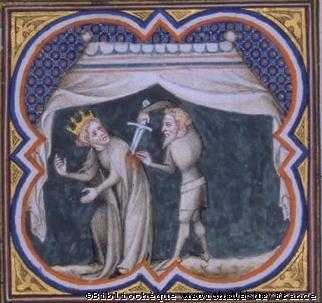
Assassination of Sigebert (National Library of France)
The reunification of Clotaire II
Now there are only two kingdoms:
- Austrasia and Burgundy (former Burgundian territory) governed by Childebert II. On the latter's death, the kingdom was therefore shared between his sons:Théodebert II (Austrasia) and Thierry II (Burgundy).
- Neustria governed by Frédégonde and her son Clotaire II.
Very quickly, Clotaire II takes control of the kingdom of Neustria. Intelligent, he will take advantage of the quarrel between the two brothers Théodebert and Thierry. He allies himself with Thierry and defeats Théodebert, thereafter he breaks the alliance with Thierry and has Brunehaut and the heirs of the kingdom of Austrasia executed. Thus Clotaire II manages to reign over the entire Frankish kingdom (as Clovis and Clotaire I had done). On his death, the kingdom was again shared between his two sons Dagobert I and Caribert II. The elder Dagobert will manage to restore the unity of the Frankish monarchy.
Merovingian legends
Merovingian legends
The origin of the Merovingians is still a mystery, it has fueled legendary stories:We find the origin of the Merovingians in Ancient Greece, particularly in Arcadia, people of origin of Callisto (that Zeus changed into a constellation:the Big Dipper) , its inhabitants notably participated in the Trojan War. This people then crossed the Rhine to join the Franks. The inhabitants of Arcadia are descended according to legend from one of the twelve tribes of Israel. The Merovingians had a birthmark (a red cross on the shoulder blades), in the Bible we find this passage which alludes to it:"... the very high protects him every day and remains between his two shoulders". Even more fantastically, some argue that the Merovingians would be the descendants of Jesus Christ and Mary Magdalene. After the crucifixion, Marie-Madeleine would have gone to Gaul and would have given birth there. This essential mystery would have been protected by secret associations such as the Templars. The origin of the Merovingians remains obscure, it is also said that the wife of Clodion, pregnant with Merovée, went to bathe one day in the ocean, there she was seduced by "the beast of Neptune", a sea animal which made her pregnant one day. second time. This could partly explain the supernatural powers of some Merovingian kings (healing, extra-sensory communication...). Big names are affiliated with the Merovingians, this is the case of Godefroi de Bouillon (hero of the first crusade and king of Jerusalem), or the Habsburg-Lorraine (from which Marie-Louise, wife of Napoleon I came) or Alain Poher (President of the Republic on the death of Pompidou). According to legend, Godefroi de Bouillon is a close descendant of Lohengrin, son of Perceval (who discovered the Grail according to Arthurian legend).
Childeric's visions
On the first wedding night, Queen Basine wakes up Childéric and asks him to look in the courtyard. Childeric sees lions, unicorns and leopards there. He goes back to bed but Basine forces him to get up and look out the window, the king then sees bears and wolves there. The third time, he sees dogs and other puny beasts. After spending the night chastely, Basine reveals to him the meaning of his dream:“A lion will be born to us; his brave sons will have the leopard and the unicorn as symbols. From them will be born bears or wolves for courage and voracity. The last kings are dogs, and the crowd of small animals indicates those who will vex the people, badly defended by their kings”. These visions bear witness to the coming degeneration of the Merovingians.
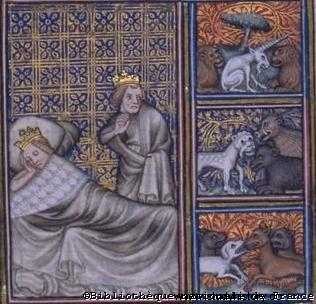
Visions of Childeric (National Library of France)
